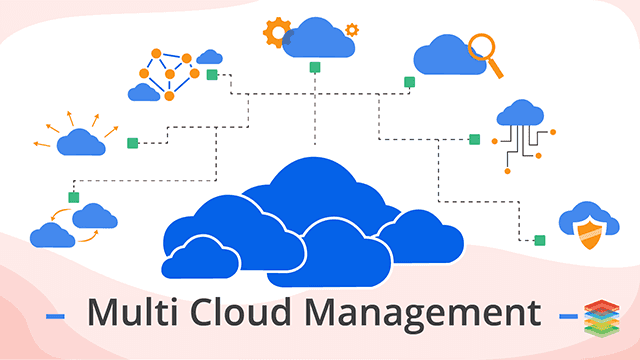
What is Multi Cloud Environment?
As per Wikipedia – “Multi-cloud is the use of multiple cloud computing and storage services in a single heterogeneous architecture.
This also refers to the distribution of cloud assets, software, applications, etc. across several cloud-hosting environments.
With a typical multi-cloud architecture utilizing two or more public clouds as well as multiple private clouds, a multi-cloud environment aims to eliminate the reliance on any single cloud provider
“Multi-cloud refers to a combination of various public clouds all functioning simultaneously.
An organization using multiple public clouds of different companies is called a multi-cloud deployment—businesses with multi-clouds use a variety of cloud providers instead of relying on only one.
What is Multi-Cloud Environment?
In Multi-Cloud, multiple public clouds are integrated. Here high scalability & high availability are key advantages here. Also, it helps in facilitating vendor migration.
It should not get confused with Hybrid Cloud, which is a computing environment that combines private cloud ( on-premises datacentre) with a public cloud & on-prem infra, allowing data and applications to be shared between them.
With the proliferation of cloud providers, it’s possible to use them in parallel to maximize your infrastructure’s performance.
It’s also possible for organizations to use one cloud to power core infrastructure and another cloud to power applications.
The goal is to reduce latency, optimize network performance, save money, and provide more flexibility.
Organizations select cloud providers based on their budgets, technological preferences, geographic locations, and other factors.
It is possible for a company to use several cloud platforms at the same time, such as Amazon Web Services for disaster recovery, Google Cloud for development and testing, and Microsoft Azure for business analytics.
When to Use Multi-cloud?
Among some of the specific use cases for multi-cloud adoption, organizations include:
- Data governance:
IT systems must be placed in a safe environment for businesses to operate. Hence, backup plans should be prepared for any eventuality.
A multi-cloud platform allows companies to safeguard their data if one system becomes vulnerable to cyberattack.
The affected data can then be moved to an alternative cloud quickly in such situations.
- Apps for distantly located users:
The data center or your headquarters has to be close to your target users when you integrate a single cloud.
Your multi-cloud strategy should be used if your target market is located distant from a preferred data center or is situated at a remote location.
Having multiple centers enables it to reach users in remote areas and reduce response times.
- Accelerated development of Modern apps
Developing apps in a modular and stylish manner is the current development trend.
The creation of functional applications requires the use of modern tools and flexible services.
This approach allows for the consumption of multiple cloud services.
- High-performance apps:
Optimizing workloads and making minimum hops between data centers and users are two essential elements to building high-performance apps. Optimizing across multiple clouds is done in an accurate and efficient manner.
Multi-cloud offers several benefits to the user.
Some of these prominent benefits are:
- No Single Points of Failure
Multi-cloud solutions reduce the risk of single points of failure.
The problem will therefore have a low likelihood of affecting the entire application if it affects just one component.
Also, the risk of DDoS attacks is also reduced when relying on multiple clouds.
Due to the potential loss of hours resulting from downtime, removing these applications from the network should be a last resort.
Businesses will not suffer from system outages using cloud computing because it offers redundant storage and resources.
- Competitive Pricing
Cloud providers are competing fiercely as they attempt to meet users’ unique resource capacity needs with flexible pricing while maintaining a high standard of service.
As a result, small businesses can compare IT rates and fees from multiple providers depending on their individual needs.
Due to the fact that cloud providers do not have mandatory terms, you can choose based on their features, such as capacity customization, licensing flexibility, and payment options.
- Flexibility and Scalability
There has been an explosion of data created over the past two years.
By virtue of proper automation and real-time synchronization, multi-cloud allows businesses to store and process data efficiently.
Businesses that utilize multi-cloud technologies can scale up and down their storage depending on their storage requirements, thereby improving their scalability and storage.
By utilizing multiple providers, organizations can invest in the level of storage, security, and protection that their business segments require.
- Enhanced Risk Management
Risk management is also a benefit of adopting a multi-cloud strategy. In case their vendor’s infrastructure suffers an attack or meltdown, users of multi-cloud services can switch to another cloud provider, including a private cloud.
In order for us to implement a more robust risk management system, it is important to implement a multi-layered security approach. Cloud providers can mitigate the risk of breaches by implementing redundant, independent systems, consolidating API components, and performing vulnerability testing.
Conclusion: What is Multi Cloud Environment?
Multi-cloud means several different public clouds are used to support one or more applications, instead of just a single public cloud.
For businesses that rely on their IT infrastructure critically, the development of a multi-cloud strategy can be extremely beneficial.
Here, an organization leverages two or more cloud computing platforms to perform various tasks.
Organizations need not depend on a single cloud provider. Also they have the flexibility to use resources from several providers to get the best benefits from each unique service
As more companies implement large-scale multi-cloud strategies, it is imperative that companies ensure they get the best capabilities for application deployment, storage, networking, security, and management.
Next Article
What is Digital Factory Concept? How do you make a digital factory?

